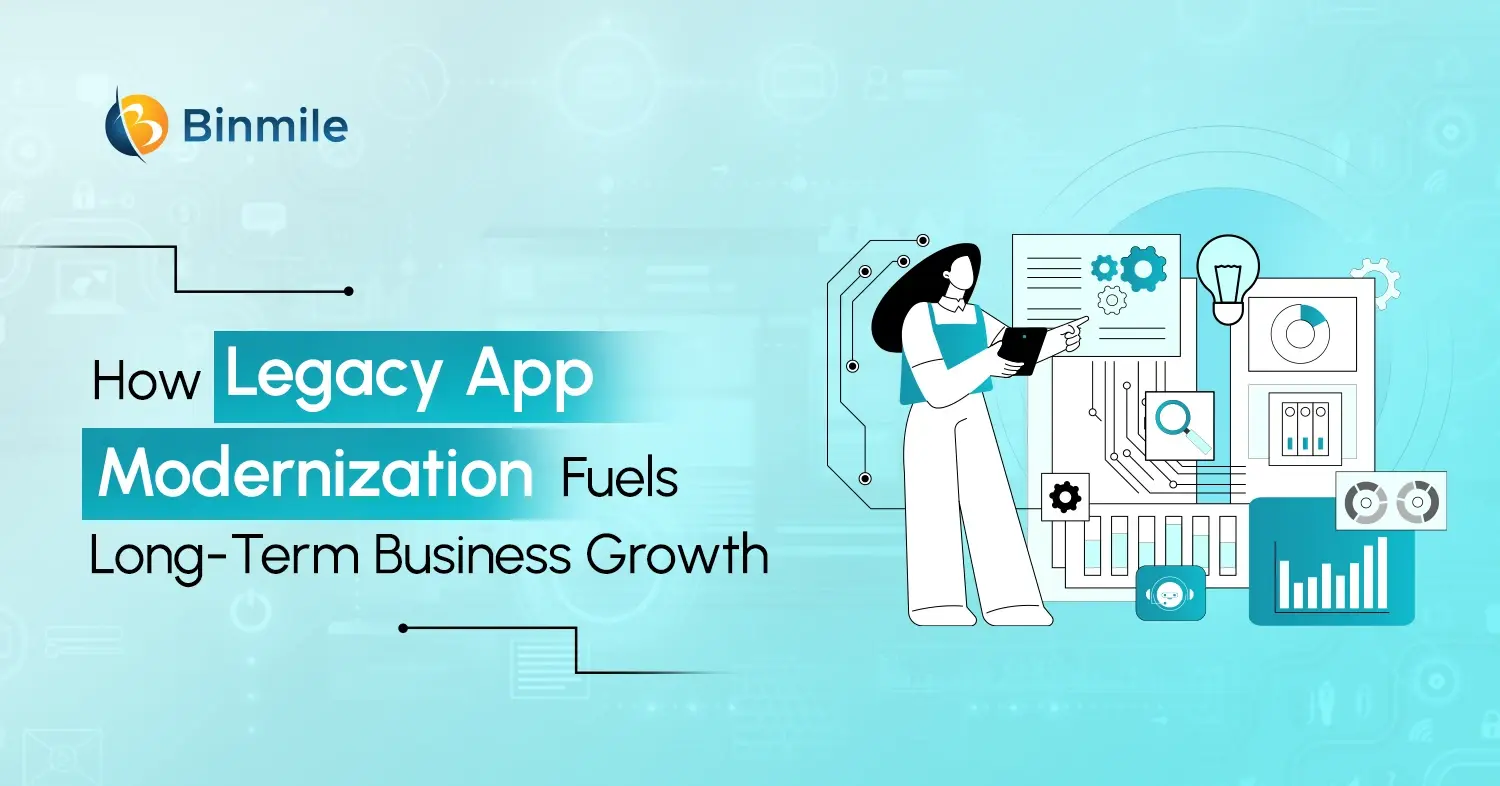A large number of enterprises continue with their legacy systems and lose the benefits of modernizing their legacy IT platforms. The modernization of legacy platforms and systems is essential for advancing innovation, refining customer experiences, enhancing reliability, and remaining competitive. Legacy application modernization can be an open-ended drive when it comes to streamlining engineering process efficiency, progressing business performance, and generating new ways of serving customers. Primarily, application modernization services from a technology company include API-based connectivity and integration services. These services include application decommission and end-of-life management; application lift and shift; business rules extraction; monolithic applications to micro-services; SOA enablement, and user interface and experience redesign. Let’s read the content and find out some of the standard techniques for legacy system modernization.
What is a Legacy System?
A Legacy System is an obsolete computing software or hardware that is still operating. Such systems still fulfill the requirements of business operations it was actually designed for, but don’t have scope for growth. Whatever tasks a legacy system performs for the company now is all it will ever do. The fact that a legacy system is equipped with older technology prevents it from interacting with newer systems, which creates obstacles for legacy system modernization.
Still, you will be surprised to know that there are a lot of reasons as to why a company would be using legacy systems down the line.
#1 Fear
Implementing change is difficult. And shifting a whole company or just a single department to a new system can trigger some internal resistance.
#2 Investment
Although maintaining a legacy system is a pricey decision in the long run, upgrading to a new system requires a massive upfront investment, not just in terms of money but manpower too.
#3 Difficulty
The legacy software may be developed with an outdated programming language that makes it difficult to find professionals with the relevant skills to carry out the migration job easily. There may be limited documentation about the system at one’s disposal and the developers who might have worked on that software left the company. There are instances where planning the migration of data from a legacy system and defining the scope of requirements for a new system appears to be overwhelming, thus hindering legacy system modernization.
Problems Caused by Not Opting for Legacy System Modernization
A legacy system can cause a wide range of issues, like high maintenance costs, data silos that resists integration between systems, inferior security, and noncompliance with governmental regulations. These troubles ultimately outweigh the convenience of sticking with an existing legacy system and highlight the need of modernize legacy system.
1. Maintenance is Expensive
Maintenance is something that is required for any system, but the cost of maintaining a legacy system is on the higher side. What else? Maintenance keeps the legacy systems running, but it requires the company to put a good amount of money on it at the same time. The situation remains the same, but there is no chance for growth with the legacy system.
At some point, you will barely find support for a legacy system and there won’t be any more updates. If the system crashes, you won’t have anyone to turn to. In short, a legacy system makes a company incur maintenance charges but fails to provide new and innovative services according to a top software development company.
2. Compliance is Tougher
These days companies must abide by stringent compliance regulations. As these regulations continue to evolve, a legacy system might not be capable enough to align with them, thus indicating the need for legacy system modernization.
Compliance regulations like the GDPR, for example, require an organization to know and prove:
- What kind of customer data do they store?
- Where is that data stored?
- Who is accessing that data?
Organizations keeping precious consumer data need to maintain well-governed records, which is almost infeasible in obsolete, siloed systems.
3. Data is Stuck in Silos
As per a leading legacy app modernization services provider, the data silo is the product of a legacy system. Most of the older systems were not designed to incorporate with each other and several legacy systems are developed on frameworks that can’t incorporate with newer systems. This means that each legacy system represents a data silo itself.
Additionally, legacy systems keep the departments that use siloed data out of data integration taking place in the rest of the departments of the organization. For example, if one team continues to work with a legacy system while the remaining team upgrades, then that one team will be isolated from business intelligence and insights that are generated in the integrated systems.
4. Security Gets Weaker
A data breach can cause a huge loss to a company and legacy systems are more vulnerable to hackers compared to newer ones. Legacy systems are equipped with outdated data security measures, for example, hard passwords, which was not a problem earlier, but it is now. As per a top legacy system modernization company, a legacy system can leave an establishment behind with its old technology along with damaging its reputation for putting data at risk of a breach. At some point, a vendor may fail to support the legacy system or offer much-needed updates, exposing the legacy system to a security risk. Conclusively, as technology advances, the risk grows for legacy systems big time.
5. New Systems Don’t Integrate
As an organization grows, adding new yet modern systems is essential to remain competitive these days. What’s more? The older technology used in legacy systems doesn’t allow interaction with a new system, preventing different departments using a legacy system from getting all the benefits that a new system offers. This hinders the ability for technological growth in an organization.
Read Also: Change Data Capture Guide
Techniques of Legacy System Modernization
Fully automated migration involves advanced technologies to transform legacy code and data into modern platforms. That is why organizations safely tackle modernization initiatives aligned with business objectives. Leon Bedaux, head of digital IT, at KPN, says, “The technology is always getting faster, and automation simpler. We need to keep up with that and the business use cases and requirements that may emerge. In this case, we replaced every platform and phased out traditional software— although in the beginning, we kept the legacy technology running until we had fully replaced the required functionality.”
Enterprises prefer to replace and modernize their legacy systems using strategies like Architecture-Driven Modernization (ADM), DevOps contribution, SABA framework, value-based decision model, reverse engineering model, Warrants, Maintenance, Upgrade (WMU), and renaissance model.
Legacy system aspects will be affected by the following legacy application modernization techniques:
- Technology platform – Encapsulation, re-hosting, and re-platforming
- Technology and architecture – Refactoring and re-architecting
- Functionality – Technology and architecture domains. Rebuilding and replacing allow for changing and adding functions and features, among other things.
Stefan van der Zijden, the senior director analyst at Gartner, says: “If you’re faced with a legacy challenge, the best approach depends on the problem you’re trying to solve. Replacement isn’t the only option. The key is to understand if your problem is caused by technology, architecture, or functionality of the application, and how each modernization approach improves those aspects”.
According to International Data Corporation (IDC), about 65% of organizations will aggressively remodel legacy systems with extensive new technology platform investments through 2023. Moreover, digital transformation spending will grow over 53% from 36% by 2023. The efficiency of the invested funds will depend upon the approach that an enterprise chooses to follow. When it comes to sticking to unique legacy modernization techniques approaches, the following specific techniques are applied to update outdated technologies.

Unique Modernization Techniques for Legacy Apps
- Code refactoring relates to restructuring and optimizing prevailing code without altering its external behavior. It is like an application component that solves technology problems and improves the features and structure of the element.
- Encapsulation is a technique for reprocessing legacy software components, leveraging the application, and extending application features and value.
- Rehosting means moving a mainframe application to modern open systems like physical, virtual, or cloud infrastructure. It is a low-cost and low-risk technique. Here, cloud migration bids flexibility over on-site hardware.
- Replatform migration includes code adjustment to a new platform while conserving existing functionality. In the cloud, this technique ensures base cloud functionality and cost optimization.
- Rearchitecting is vital for moving to new application architecture. It also exploits better platform capabilities while altering the code. This technique has medium cost and risk but also medium results.
As per IDC Worldwide predictions on Digital Transformation, about 90% of all new apps will feature microservices architectures by 2022 to improve the ability to design, debug, update, and leverage third-party code.
- Rebuilding (Redesign) safely rewrites the application components from the beginning to preserve the scope and specifications of the app component.
- Replacing is related to entirely replacing the app rather than investing in modernization with a different tool.
Free Download: Case Study on Application Modernization Services
Final Thoughts
Undoubtedly, legacy systems can help you get a competitive edge in the market. All mentioned above techniques are useful for having a successful legacy system modernization process. Modern enterprises can shake hands with application modernization agencies to make things happen in their favor.
Make the most out of your existing legacy systems with a perfect legacy application modernization strategy from a reputable software development company.









